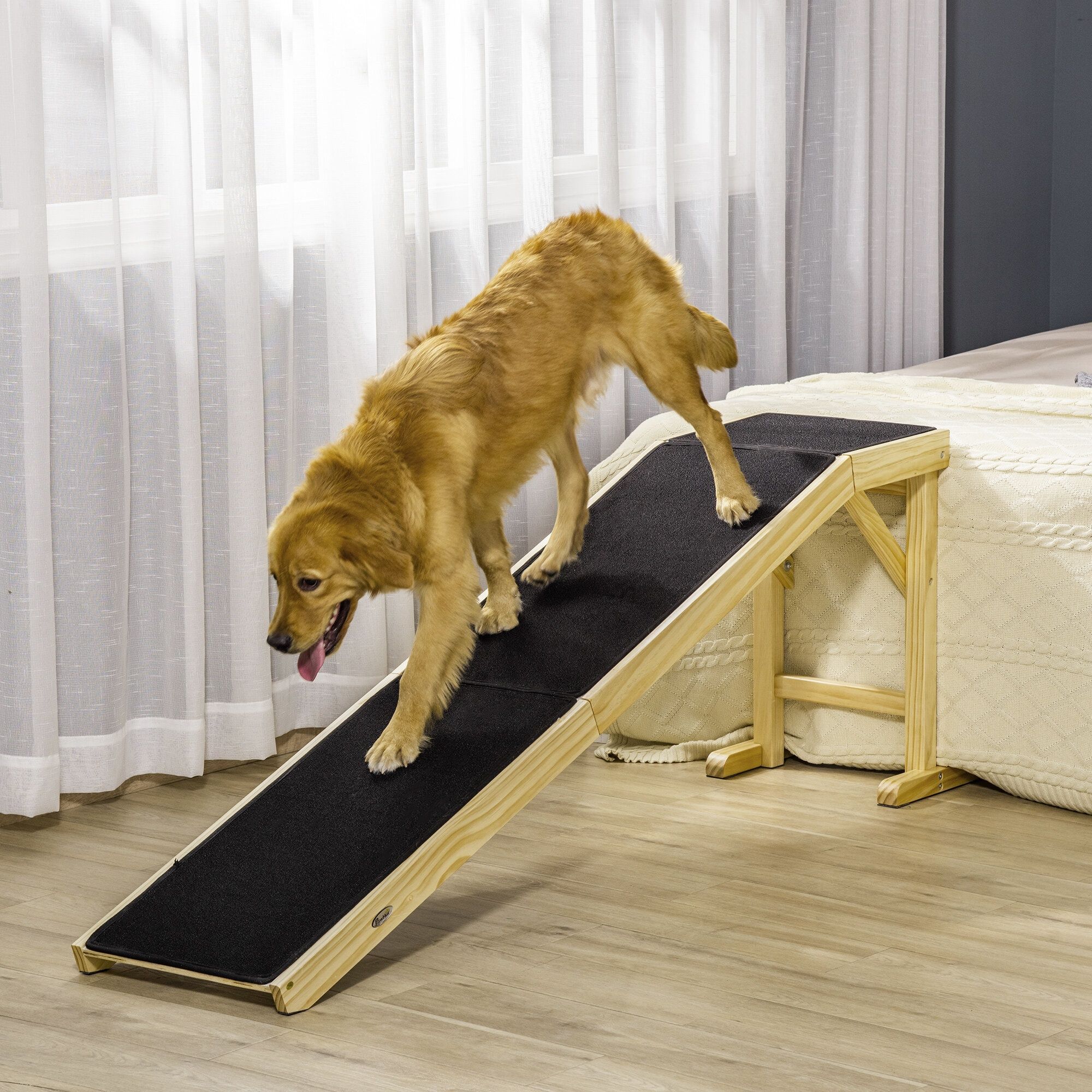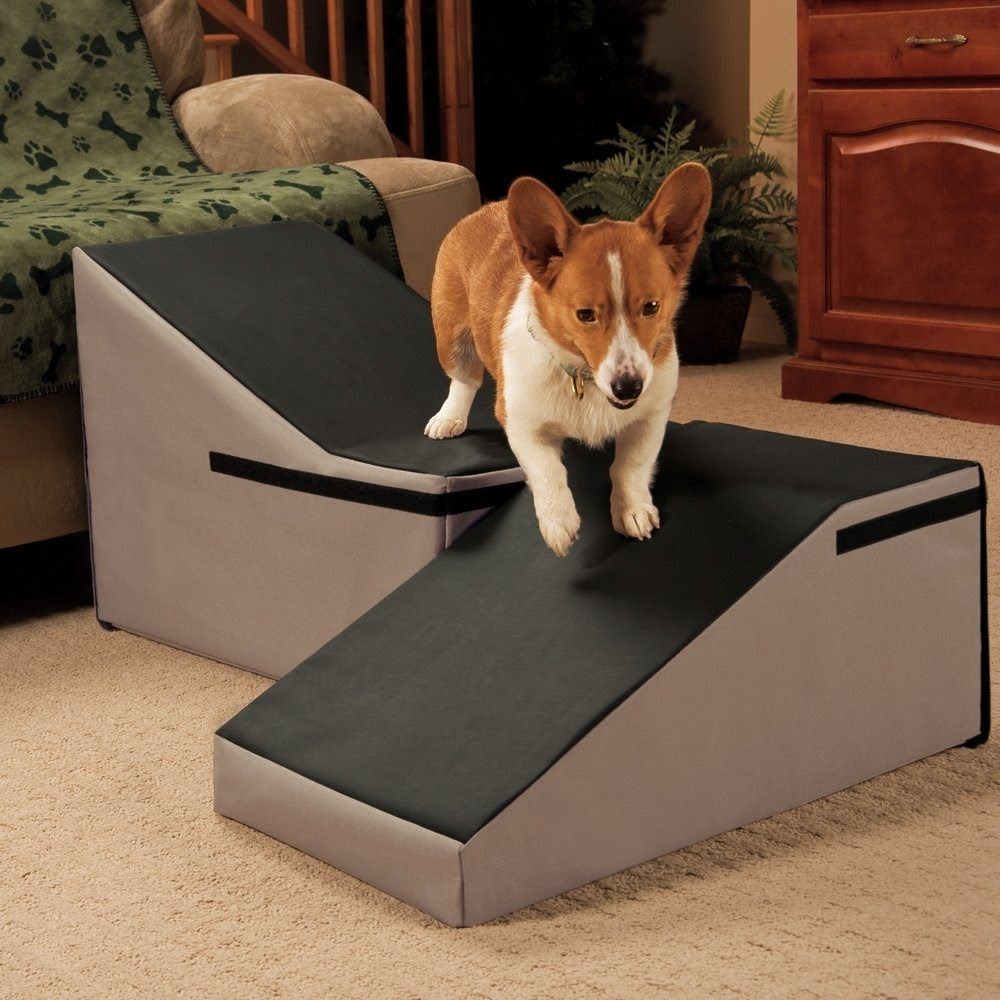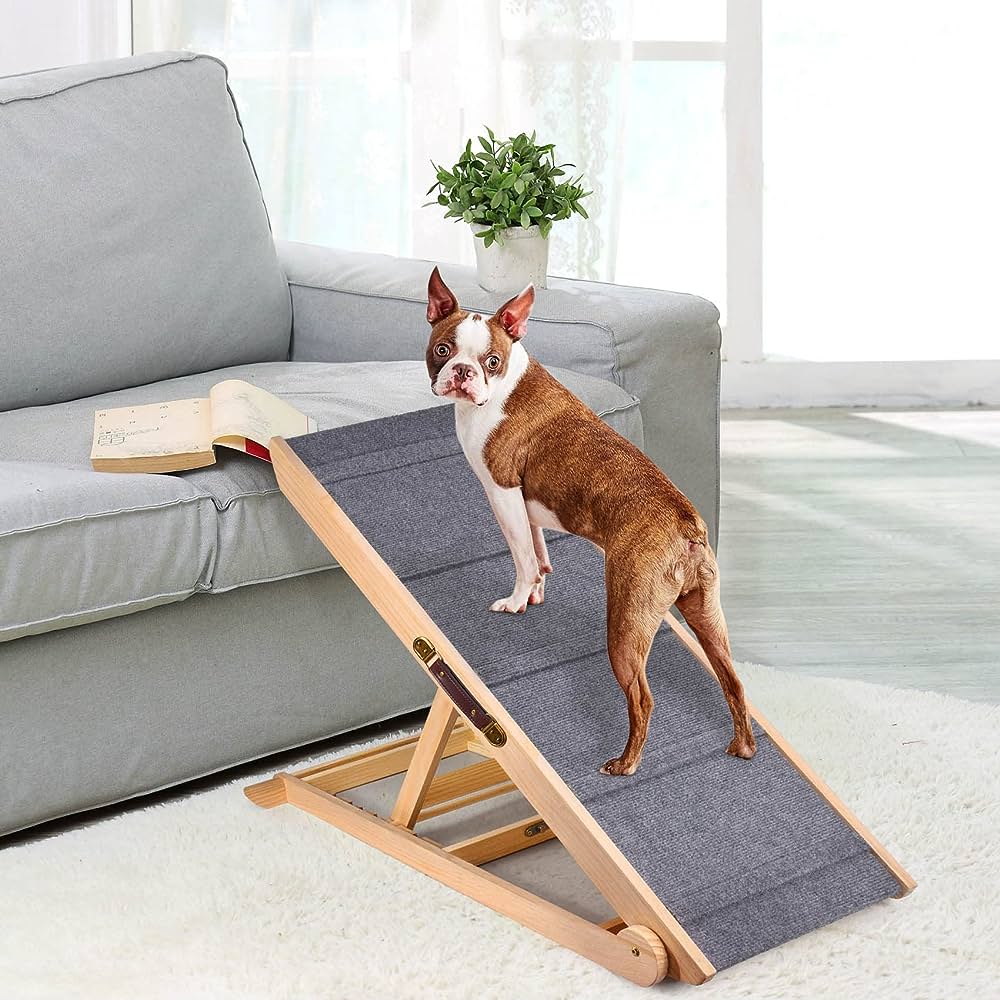Are you a dog owner looking to improve the comfort and mobility of your furry friend? If so, a dog bed ramp might be the perfect addition to your home. In this article, we'll explore the benefits of using a dog bed ramp, the different types available, and how to choose the right one for your beloved pet. So, let's dive in!

Understanding the Needs of Dogs
As dogs age, they often face health concerns, just like humans. Mobility becomes a challenge, especially for those with joint problems or arthritis. Jumping on and off furniture, including beds, can put immense stress on their joints. A dog bed ramp can provide a gradual incline, allowing your pet to reach their resting spot without putting unnecessary strain on their bodies.
Types of Dog Bed Ramps
Now that we understand the importance of dog bed ramps let's explore the different types available in the market.
Folding Dog Bed Ramps for Easy Storage
Folding dog bed ramps are perfect for those who have limited space in their homes. These ramps can be easily folded and stored away when not in use, making them convenient and practical. They are often lightweight, making them ideal for travel and outdoor adventures with your furry friend.
Fixed Dog Bed Ramps for Stability
Fixed dog bed ramps are a permanent solution for providing access to elevated surfaces.
They are designed to be sturdy and stable, ensuring your happy dog can use them with confidence. Fixed ramps are usually made from durable materials, making them suitable for long-term use.
Adjustable Dog Bed Ramps for Versatility
If you have multiple furniture pieces of varying heights, an adjustable dog bed ramp might be the best choice. These ramps come with adjustable legs or sections, allowing you to customize the ramp's length and incline to fit different surfaces. They offer versatility and convenience, especially if you have various resting spots for your dog around the house.
Choosing the Right Dog Bed Ramp
When selecting a dog bed ramp, there are several crucial factors to consider to ensure it meets your dog's needs and preferences. Here are some key points to keep in mind:
a. Size: The ramp's size should be appropriate for your dog's breed and size. Consider their height, weight, and length to ensure a comfortable and safe incline.
b. Material: Dog bed ramps can be made from various materials like wood, plastic, or metal. Choose a material that is sturdy, durable, and non-slip to provide stability for your furry friend.
c. Incline: The incline or slope of the ramp matters to prevent strain on your dog's joints. A gradual slope is generally better for most dogs, especially those with mobility issues.
d. Weight capacity: Check the weight capacity of the ramp to ensure it can safely support your dog's weight. It's better to choose a ramp with a higher weight capacity than necessary to be on the safe side.
e. Portability: If you plan to use the ramp in different locations or while traveling, consider a portable and lightweight option that is easy to fold or dismantle.
f. Safety features: Look for safety features such as non-skid surfaces, guardrails, and anti-slip feet to prevent accidents and make the ramp more user-friendly.
g. Cleaning and maintenance: Opt for a ramp that is easy to clean and maintain since dogs can bring in dirt and debris from outside.
h. Your dog's preferences: Some good family dogs may be more comfortable with certain ramp styles or materials. Observe your dog's behavior and preferences to find the most suitable option.

- DIY Dog Bed Ramp vs. Store-Bought
When deciding between a DIY dog bed ramp and a store-bought one, consider the following factors:
DIY Dog Bed Ramp:
- Cost: Building a DIY ramp may be more cost-effective, as you can use materials you already have or find affordable options.
- Customization: With a DIY ramp, you can tailor the size, material, and design to fit your dog's specific needs and the aesthetics of your home.
- Skill level: Depending on the complexity of the design, building a DIY ramp may require some basic woodworking or crafting skills.
- Time: Creating a DIY ramp may take more time, especially if you're not experienced in such projects.
- Safety: Ensure that your DIY ramp is secure and safe for your dog to use. Double-check stability and non-slip features.
Store-Bought Dog Bed Ramp:
- Convenience: Store-bought ramps are ready to use, saving you time and effort.
- Quality and safety: Reputable pet ramps sold in stores are usually well-designed and tested for safety, giving you peace of mind.
- Variety: There is a wide range of options available in pet stores, catering to different dog sizes and preferences.
- Return policy: If the ramp doesn't suit your dog, you can usually return it within a specified period, depending on the store's policy.
- Cost: Store-bought ramps might be more expensive than a DIY option, especially for high-quality, durable models.
Ultimately, the decision between a DIY dog bed ramp and a store-bought one depends on your budget, time, skills, and your dog's specific needs. Whichever option you choose, prioritize your dog's safety, comfort, and well-being.
Training Your Dog to Use the Bed Ramp
Training your dog to use the bed ramp requires patience, positive reinforcement, and consistency. Here's a step-by-step guide to help you train your furry companion:
- Introduce the Ramp Gradually: Place the bed ramp near your dog's favorite spot or their bed. Allow them to explore it at their own pace without any pressure. Let them sniff and investigate the ramp to get familiar with it.
- Use Treats and Praise: Encourage your dog to approach and walk on the ramp by using treats or their favorite puzzle toys. Place treats along the ramp to entice them to walk on it. Use a cheerful and encouraging tone to praise them whenever they make progress.
- Start with the Lower Incline: If your ramp is adjustable, begin with a lower incline to make it easier for your dog. As they become comfortable, gradually increase the incline to match the height of the bed.
- Guide Your Dog: Initially, you might need to guide your dog up and down the ramp. Use a leash or gently hold their collar to guide them. Be patient and avoid pulling or forcing them, as this may create fear or resistance.
- Create Positive Associations: Make the ramp a positive and rewarding experience for your dog. Every time they use the ramp successfully, reward them with treats, praise, and affection.
- Repeat and Be Patient: Training takes time, and every dog learns at their own pace. Be patient and consistent in your efforts. Repeat the training sessions daily, keeping them short and positive.
- Offer Assistance if Needed: For dogs with mobility issues or those who are hesitant, you can use a towel or a pet-friendly ramp cover with better traction to help them gain confidence.
- Gradually Remove Assistance: As your dog becomes more comfortable using the ramp, start reducing your physical assistance. Allow them to walk up and down the ramp independently.
- Practice Regularly: Even after your dog has mastered using the ramp, continue practicing regularly to reinforce their training and keep the behavior consistent.
- Use Verbal Cues: Introduce simple verbal cues like "up" and "down" to signal your dog to use the ramp. With time and practice, they will associate these cues with the desired action.
Remember that each dog is unique, and the training process may vary. Some dogs might take to the ramp quickly, while others may require more time and encouragement. Always prioritize positive reinforcement and make the training sessions enjoyable for your furry friend. If your dog seems overly anxious or fearful, consider seeking the guidance of a professional dog trainer to ensure a positive and successful training experience.

Integrating the Ramp into Your Home
Integrating the ramp into your home involves strategically placing and securing the ramp to ensure ease of use for your dog. Here are some tips on how to seamlessly incorporate the ramp into your living space:
- Choose the Right Location: Select a location where your dog frequently needs access, such as next to their bed or a favorite resting spot. Ensure there is enough space for your dog to approach and use the ramp comfortably.
- Secure the Ramp: Whether you have a store-bought or DIY ramp, make sure it is stable and securely placed. Some ramps come with non-slip feet or adhesive strips to keep them in place. If needed, consider using mounting brackets or anchors to fasten the ramp to the bed or furniture for added stability.
- Carpet or Traction: If the ramp's surface is too slippery for your dog, add a non-slip surface such as a carpet or a rubber mat. This will provide better traction and prevent any accidents.
- Blend with the Décor: If aesthetics are a concern, choose a ramp that complements your home's interior. Some ramps come in various colors or finishes that can match your furniture or blend into the background.
- Foldable or Removable Ramps: If you prefer to use the ramp only occasionally or need to store it away when not in use, opt for a foldable or removable design. These types of ramps can be easily stored in a closet or under the bed.
- Get Your Dog Used to the Ramp: As mentioned in the previous section, train your dog to use the ramp comfortably. Familiarize them with the ramp's location so they can access it whenever needed.
- Safety First: Double-check that there are no hazards or obstacles around the ramp that could cause accidents. Keep the area well-lit to help your dog feel more at ease when using the ramp, especially during nighttime.
- Consider Multiple Ramps: If your dog needs access to different furniture or areas in your home, you may need multiple ramps. Having ramps in strategic locations will make it easier for your dog to move around freely.
- Regular Maintenance: Keep the ramp clean and in good condition. Regularly inspect the ramp for any signs of wear or damage, and address any issues promptly.
- Be Patient and Encouraging: During the integration process, be patient with your dog as they adjust to the new ramp. Continue to use positive reinforcement to encourage them to use it regularly.
By carefully integrating the ramp into your home and creating a positive association for your dog, they will quickly adapt to using it, improving their mobility and overall quality of life.
Maintenance and Care
Proper maintenance and care are essential to ensure the longevity and safety of your dog bed ramp. Here are some maintenance tips to keep the ramp in good condition:
- Regular Cleaning: Clean the ramp regularly to remove dirt, debris, and pet hair. Use a mild pet-safe detergent and water to wipe down the ramp's surface. Avoid harsh chemicals that could be harmful to your dog.
- Check for Wear and Tear: Inspect the ramp for any signs of wear, loose parts, or damage. Pay special attention to the non-slip surface, edges, and hinges (if applicable). Address any issues promptly to prevent accidents.
- Tighten Screws and Bolts: If your ramp has screws or bolts, check them periodically to ensure they are securely tightened. Loose screws can compromise the ramp's stability.
- Lubricate Moving Parts: If your ramp has moving parts like hinges, consider lubricating them with pet-safe lubricants to keep them functioning smoothly.
- Store Properly: If you have a foldable or removable ramp, store it in a dry and safe place when not in use. Avoid exposing the ramp to extreme weather conditions that could lead to warping or damage.
- Replace Worn Parts: If any part of the ramp becomes significantly worn or damaged, replace it immediately with suitable replacement parts from the manufacturer or supplier.
- Trim Your Dog's Nails: Long nails can cause scratches on the ramp's surface. Keep your dog's nails trimmed to minimize potential damage.
- Keep the Ramp Dry: If the ramp gets wet, dry it thoroughly to prevent mold or mildew growth.
- Read Manufacturer's Guidelines: Follow any specific maintenance instructions provided by the manufacturer to ensure proper care for your dog bed ramp.

Addressing Safety Concerns with the Dog Bed Ramp:
Safety should always be a top priority when using a dog bed ramp. Here are some safety tips to address potential concerns:
- Weight Capacity: Ensure that the ramp's weight capacity is suitable for your dog's size and weight. Using a ramp beyond its capacity could lead to structural failure.
- Non-Slip Surface: If the ramp's surface doesn't provide adequate traction, add a non-slip mat or carpet to prevent slips and falls.
- Secure Placement: Make sure the ramp is securely placed against the bed or furniture. If needed, use mounting brackets or anchors to prevent the ramp from slipping.
- Gradual Incline: If the ramp is adjustable, set it to a gradual incline to avoid putting excessive strain on your dog's joints.
- Supervision: Initially, supervise your dog while using the ramp to ensure they are comfortable and safe. Offer support and guidance if needed.
- Address Fear or Separation Anxiety: If your dog is fearful or hesitant about using the ramp, be patient and use positive reinforcement to build their confidence.
- Avoid Steep Ramps: Steep ramps can be difficult for dogs to navigate, especially those with mobility issues. Choose a ramp with a gentle incline.
- No Sharp Edges: Check for any sharp edges or rough spots on the ramp that could injure your dog. Smooth out any rough areas.
- Regular Inspections: Regularly inspect the ramp for signs of wear, damage, or safety hazards. Address any issues immediately.
- Consult a Professional: If your dog has specific health issues or mobility challenges, consider consulting with a veterinarian or a professional dog trainer for personalized advice and recommendations.
By following these maintenance and safety guidelines, you can ensure that your dog bed ramp remains in good condition and provides a safe and convenient means for your furry companion to access their favorite spots.

Conclusion
A dog bed ramp is a practical and thoughtful addition to your home if you have a furry friend. It provides comfort and ease of mobility, especially for aging or ailing dogs. Remember to choose the right type of ramp, train your dog to use it, and maintain it regularly for optimal results.
FAQs (Frequently Asked Questions)
1. Can a dog bed ramp be used for all dog breeds?
Yes, dog bed ramps can be used for all dog breeds. It is essential to choose a ramp that suits your dog's size and weight for safety and comfort.
2. How do I know the right size of ramp for my dog?
Measure the height of your bed or furniture and consider your dog's size and mobility. Choose a ramp with an appropriate length and weight capacity.
3. Can puppies use a bed ramp?
Yes, puppies can use a bed ramp. Introducing them to a ramp early can help prevent joint issues later in life.
4. Are there weight restrictions for dog bed ramps?
Yes, each dog bed ramp has a weight capacity specified by the manufacturer. Make sure to choose one that can support your dog's weight.
5. How long does it take for a dog to get used to the ramp?
It varies from dog to dog. Some may get used to it within a few days, while others may take a few weeks to feel comfortable using the ramp. Be patient and consistent during the training process.





